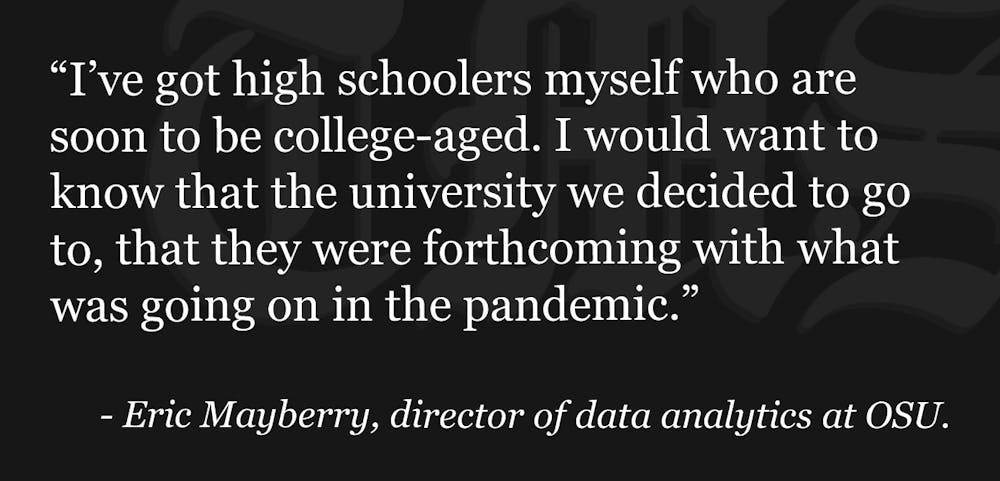Miami University’s COVID-19 dashboard gets a B+ grade according to independent research group “We Rate Covid Dashboards” (WRCD).
Rankings are based on a 14-point scale, with grades ranging from A+++ for all 14 points to F for no dashboard. Miami’s grade means our dashboard earned eight points – just more than half the total possible.
Carole Johnson, Miami’s associate director for university news and communications, wrote in an email to The Miami Student that the dashboard is maintained by a collaborative effort between multiple university departments. Student Health Services, Butler County TriHealth and residence life provide the data, while University Marketing and Communications compiles and presents it.
“We believe that an informed community can help lead to a healthy community where its members can make knowledgeable decisions about their health and safety based on data,” Johnson wrote.
Cary Gross, a professor of medicine and public health at Yale University, started WRCD with his friend and fellow faculty member Howard Forman. The pair began working with students last spring to develop standards for how colleges should share COVID-19 data accurately and transparently.
“When we first started doing these ratings toward the end of last spring semester, quite a few colleges reached out to us to ask [questions],” Gross said. “Colleges were hungry not only for feedback, but for some explicit expectations about what should be in their dashboards.”
Nearly a year later, the team has grown to include students and faculty from Ohio State University, Amherst College, Harvard University and Baylor College of Medicine.
Dashboards are ranked on how frequently data is updated, whether city and county data is made available, if they list students in quarantine and isolation and other factors.
Gross said 10 of the 11 current ranking criteria are objective measures. Only one, whether the dashboard is easy to read, leaves room for subjective judgement.
Miami’s eight points come from seven categories. According to WRCD, the dashboard is easy to read, is updated daily and presents both the number of positive cases and the number of tests given. Additionally, the dashboard earned a mark for distinguishing between student and staff cases.
The university lacks points in two newly added categories: accessibility and a vaccination plan.
Before these two standards were added, Miami’s dashboard had an A rating with 10 out of 14 points. When WRCD reevaluated the dashboard with these new categories in mind on Feb. 16, Miami dropped to its current B+ grade.
Enjoy what you're reading?
Signup for our newsletter
“One of the comments that we’ve received repeatedly through this process is that [we] really need to be evaluating the accessibility of college dashboards,” Gross said. “We were contacted by experts from Amherst in digital accessibility. They went through and worked with us to create a new criteria of accessibility that we’re just starting to roll out moving forward.”
WRCD judges accessibility against the second iteration of Web Content Accessibility Guidelines (WCAG 2.1). Each dashboard should have keyboard navigation for interactive elements, alt-text for graphics and color contrast, and users should be able to zoom in to 200% without losing functionality.
Even though Miami didn’t get a positive mark for accessibility, Johnson said the dashboard meets accessibility requirements.
“The Dashboard has been built to meet WCAG 2.0 AA requirements established by the World Wide Web Consortium (W3C) in accordance with the Americans with Disabilities Act (ADA),” Johnson wrote.
WCAG 2.0 was established in 2008 and updated 10 years later to WCAG 2.1.
Miami’s dashboard doesn’t fully address how frequently students are tested, either. It provides information on how many total tests are conducted each day and week, but no information on how often students can expect to be tested.
Currently, Miami uses both wide-net and surveillance testing to detect student cases. While this results in frequent testing overall, nearly 3,000 in the past week alone, students don’t know whether they will be tested once a week, once a month or once a semester.
WRCD also takes off a point for every dashboard that fails to display city or county data. Miami’s dashboard has a link to Butler County’s COVID-19 dashboard but does not embed it directly into the website.
Gross said in keeping with WRCD’s mission to promote transparency, its website provides resources for schools to add county data directly to their own dashboards and make them more accessible.
“We can’t remake everyone’s dashboard for them,” Gross said, “but we’re providing resources where colleges can see how to make their dashboards accessible.”
Eric Mayberry, director of data analytics at Ohio State University, joined the WRCD team as a data expert. He said data transparency is important to help the public make informed decisions during the pandemic.
“I’ve got high schoolers myself who are soon to be college-aged,” Mayberry said. “I would want to know that the university we decided to go to, that they were forthcoming with what was going on in the pandemic.”
It isn’t just the public that benefits from universities being transparent with COVID-19 data, though. Mayberry said it helps university leadership as well.
“Internally, [COVID-19] data is even more important,” Mayberry said. “Internally, being able to have that data accessible to the leadership team [allows them to] make informed decisions. I’ve always been a proponent of, ‘If you have bad data, you’re going to make bad decisions.’”
Despite the shortcomings of Miami’s COVID-19 dashboard, sophomore public health major Grace Connors said it helps her feel safe on campus.
“If [the university isn’t] being transparent, then you have no idea what’s going on,” Connors said. “That’s really misleading and unfair. In COVID times, you have to know what the cases are like around you and what your environment is so that you can make the best decisions for your health and safety but also for the safety of those around you.”
Connors uses the dashboard’s color-coded residence hall system to decide whether it’s safe to meet with friends from different parts of campus. If her friend’s hall is red or purple, the two highest levels, she reschedules plans with them.
Gross said WRCD doesn’t take residence hall information into account when ranking dashboards due to the wide range of living options available at different universities. For schools Miami’s size, though, he said it’s good data to include.
“One thing that I noticed that [Miami] does which not a lot do is reporting on the differences across the different dorms,” Gross said. “It’s not in our rating system, but I think it’s a great example of a school going above and beyond on its own.”
Still, Miami has room to improve based on WRCD’s rating. Of the 18 colleges currently rated in Ohio, Miami’s dashboard comes in sixth. That puts it above Kent State’s dashboard, which earned a C with 4 out of 14, but trails behind Ohio State University’s rating of A+, earning 12 out of 14.
“While we are pleased with our national ranking,” Johnson wrote, “we rely on our community and our health partners for feedback.”
For Gross, however, even a 10 out of 14 doesn’t cut it.
“We’re dealing with a life and death situation here,” Gross said. “I think we should not be striving for a B. I think we should be striving for an A+.”




